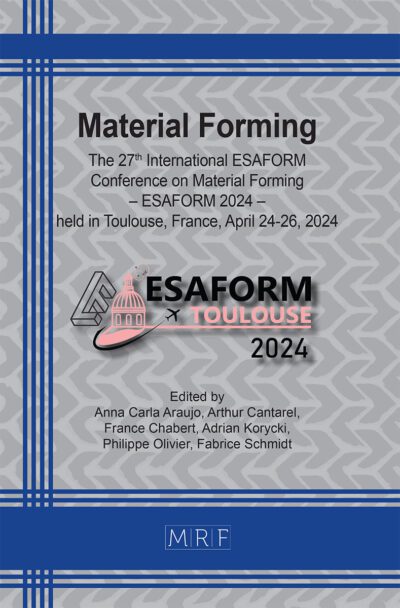Intelligent approach for accurately identifying constitutive material parameters of anisotropic tubular materials
Ali Khalfallah, Zied Ktari, Luis Filipe Menezes
Abstract. Identifying constitutive material parameters of anisotropic tubular materials is challenging, primarily due to the inherent complexities of their stress-strain behavior and their curved geometry, which hinder the ability to obtain samples cut in various directions, as is possible with sheet metals. Traditional methods, such as flattening tubes for tensile testing, often introduce pre-strains that compromise measurement accuracy. This issue is particularly critical in the hoop direction, where the mechanical properties significantly influence performance in automotive and aerospace applications. To address these challenges, a novel data-driven framework that employs intelligent approaches, including surrogate modeling, finite element analysis (FEA), and artificial neural networks (ANN) is proposed. These methods optimize specimen geometry to achieve homogeneous stress distribution during testing. The framework further enables the identification of material parameters and friction through an inverse analysis technique.
Keywords
RHTT, Specimen Geometry, Intelligent Approaches, Anisotropic Tubular Materials, Finite Element Analysis
Published online 5/7/2025, 10 pages
Copyright © 2025 by the author(s)
Published under license by Materials Research Forum LLC., Millersville PA, USA
Citation: Ali Khalfallah, Zied Ktari, Luis Filipe Menezes, Intelligent approach for accurately identifying constitutive material parameters of anisotropic tubular materials, Materials Research Proceedings, Vol. 54, pp 1500-1509, 2025
DOI: https://doi.org/10.21741/9781644903599-162
The article was published as article 162 of the book Material Forming
![]() Content from this work may be used under the terms of the Creative Commons Attribution 3.0 license. Any further distribution of this work must maintain attribution to the author(s) and the title of the work, journal citation and DOI.
Content from this work may be used under the terms of the Creative Commons Attribution 3.0 license. Any further distribution of this work must maintain attribution to the author(s) and the title of the work, journal citation and DOI.
References
[1] X. Fan, J. Liu, Z. Meng, C. Sun, Forming characteristics investigation of natural bulging area of thin-walled metallic tubes in liquid impact forming method, J. Pipeline Syst. Eng. Pract.15 (2024) 1-10.
[2] T. Zribi, A. Khalfallah, H. Belhadjsalah, Experimental characterization and inverse constitutive parameter identification of tubular materials for tube hydroforming process, Mater. Des.49 (2013) 866-877. https://doi.org/10.1016/j.matdes.2013.02.077
[3] ASTM D2290, Standard Test Method for Apparent Hoop Tensile Strength of Plastic or Reinforced Plastic Pipe by Split Disk Method. ASTM International, West Conshohocken, PA, USA (2003).
[4] R.L. Mehan, M.R. Jackson, J.R. Rairden, W.T. Carter, The use of a ring tensile
test to evaluate plasma-deposited metals. J. Mater. Sci. 22, (1987) 4476–4483. https://doi.org/10.1007/BF01132050
[5] E.G. Price, Hydride orientation and tensile properties of Zr-2.5wt%Nb pressure tubing hydrided while internally pressurized. Can. Metall. Q. 11, (1972) 129–138. https://doi.org/10.1179/cmq.1972.11.1.129
[6] H. Wang, R. Bouchard, R. Eagleson, P. Martin, W. Tyson, Ring hoop tension test
(RHTT): a test for transverse tensile properties of tubular materials. J. Test. Eval. (2002) 30,
382. https://doi.org/10.1520/JTE12328J
[7] C.P. Dick, Y.P. Korkolis, Mechanics and full-field deformation study of the ring hoop tension test. Int. J. Solid Struct. 51, (2014) 3042–3057. https://doi.org/10.1016/j.ijsolstr.2014.04.023
[8] L. Jiang, J.J. Jonas, K. Boyle, P. Martin, Deformation behavior of two Mg alloys during ring hoop tension testing. Mater. Sci. Eng. (2008) 492, 68–73. http://doi.org/10.1016/j.msea.2008.04.028
[9] H. Tarigonda, K. Lakshmi, P. Gnanaprakash, D. Raghurami Reddy, Desirability function analysis approach for optimization of fused deposition modelling process parameters. Int. J. Mater. Res., (2023) 940–946. https://doi.org/10.1515/ijmr-2022-0266
[10] T. William, S. Amos, Noisy Early Stopping for Noisy Labels. (2024) arXiv.org, abs/2409.06830 https://doi.org/10.48550/arxiv.2409.06830
[11] A. Khalfallah, Z. Ktari, C. Leitão, J.V. Fernandes, New Mandrel Design for Ring Hoop Tensile Testing. Experimental Techniques, 45, (2021) 769–787. https://doi.org/10.1007/s40799-021-00462-4












